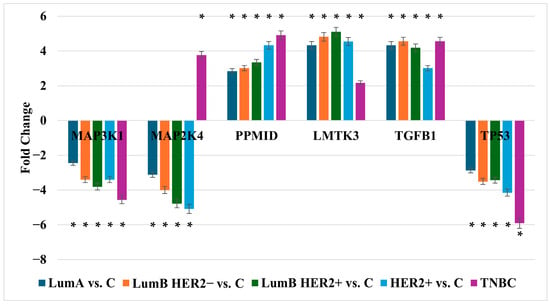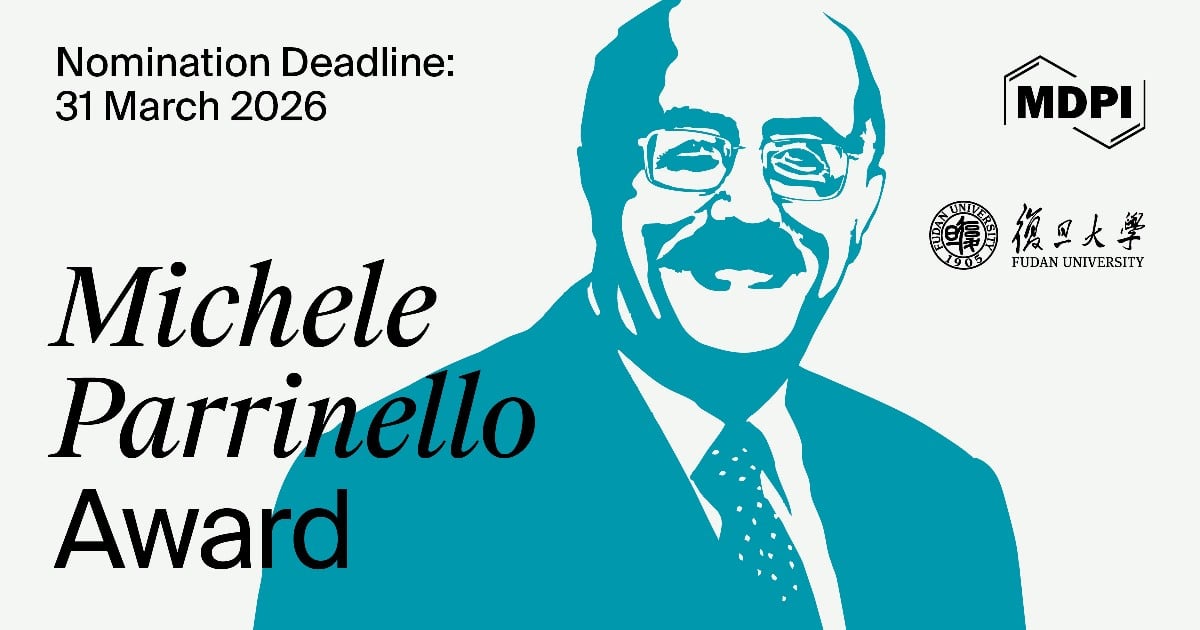-
 Functional Precision in Pancreatic Cancer: Redefining Biomarkers with Patient-Derived Organoids
Functional Precision in Pancreatic Cancer: Redefining Biomarkers with Patient-Derived Organoids -
 Are Procoagulant Platelets an Emerging Therapeutic Target? A General Review with an Emphasis on Their Clinical Significance in Companion Animals
Are Procoagulant Platelets an Emerging Therapeutic Target? A General Review with an Emphasis on Their Clinical Significance in Companion Animals -
 MASLD Under the Microscope: How microRNAs and Microbiota Shape Hepatic Metabolic Disease Progression
MASLD Under the Microscope: How microRNAs and Microbiota Shape Hepatic Metabolic Disease Progression -
 Sequencing Anti-CD19 Therapies in Diffuse Large B-Cell Lymphoma: From Mechanistic Insights to Clinical Strategies
Sequencing Anti-CD19 Therapies in Diffuse Large B-Cell Lymphoma: From Mechanistic Insights to Clinical Strategies -
 Carbon Dots for Nucleic Acid-Based Diagnostics and Therapeutics: Focus on Oxidative DNA Damage
Carbon Dots for Nucleic Acid-Based Diagnostics and Therapeutics: Focus on Oxidative DNA Damage
Journal Description
International Journal of Molecular Sciences
International Journal of Molecular Sciences
is an international, peer-reviewed, open access journal providing an advanced forum for biochemistry, molecular and cell biology, molecular biophysics, molecular medicine, and all aspects of molecular research in chemistry, and is published semimonthly online by MDPI. The Australian Society of Plant Scientists (ASPS), Epigenetics Society, European Chitin Society (EUCHIS), Spanish Society for Cell Biology (SEBC) and others are affiliated with IJMS and their members receive a discount on the article processing charges.
- Open Access— free for readers, with article processing charges (APC) paid by authors or their institutions.
- High Visibility: indexed within Scopus, SCIE (Web of Science), PubMed, PMC, MEDLINE, Embase, CAPlus / SciFinder, and other databases.
- Journal Rank: JCR - Q1 (Biochemistry and Molecular Biology) / CiteScore - Q1 (Organic Chemistry)
- Rapid Publication: manuscripts are peer-reviewed and a first decision is provided to authors approximately 20.5 days after submission; acceptance to publication is undertaken in 2.6 days (median values for papers published in this journal in the first half of 2025).
- Recognition of Reviewers: reviewers who provide timely, thorough peer-review reports receive vouchers entitling them to a discount on the APC of their next publication in any MDPI journal, in appreciation of the work done.
- Testimonials: See what our editors and authors say about IJMS.
- Companion journals for IJMS include: Biophysica, Stresses, Lymphatics and SynBio.
Impact Factor:
4.9 (2024);
5-Year Impact Factor:
5.7 (2024)
Latest Articles
Multi-Level Profiling of MAPK-Associated Genes and MicroRNAs Uncovers Regulatory Networks in Breast Cancer Subtypes
Int. J. Mol. Sci. 2025, 26(24), 11831; https://doi.org/10.3390/ijms262411831 (registering DOI) - 7 Dec 2025
Abstract
Breast cancer (BC) comprises heterogeneous subtypes with distinct molecular drivers and clinical behaviors. Among the key signaling pathways implicated in BC progression is the mitogen-activated protein kinase (MAPK) cascade, which regulates cell proliferation, apoptosis, and stress responses. microRNAs (miRNAs), as post-transcriptional regulators, are
[...] Read more.
Breast cancer (BC) comprises heterogeneous subtypes with distinct molecular drivers and clinical behaviors. Among the key signaling pathways implicated in BC progression is the mitogen-activated protein kinase (MAPK) cascade, which regulates cell proliferation, apoptosis, and stress responses. microRNAs (miRNAs), as post-transcriptional regulators, are increasingly recognized as modulators of MAPK-associated genes, yet their integrated role across BC subtypes remains incompletely understood. This study included 405 patients with histopathologically confirmed BC, stratified into luminal A (LumA), HER2-negative luminal B, HER2-positive luminal B, non-luminal HER2-positive, and triple-negative breast cancer (TNBC). Control tissues were obtained from matched surgical margins. We performed mRNA profiling (Affymetrix microarrays), reverse transcription-quantitative polymerase chain reaction (RT-qPCR), protein quantification (enzyme-linked immunosorbent assay (ELISA), and miRNA expression analysis. Predicted miRNA-mRNA interactions were analyzed using the miRDB database. Functional protein–protein interactions were explored using the STRING database. MAP3K1, MAP2K4, and TP53 were significantly downregulated across all subtypes, while PPM1D, LMTK3, and TGFB1 were upregulated, especially in TNBC. These alterations were supported by concordant changes at the protein level. Dysregulated miRNAs—miR-21-3p, miR-23c, miR-27a-3p, miR-205-3p, and miR-300—exhibited in-verse expression patterns relative to their predicted target genes. STRING analysis identified TP53 as a central hub, linking MAPK signaling with stress and apoptotic pathways. This integrated transcriptomic and miRNA profiling study reveals subtype-specific dysregulation of MAPK-associated genes and their miRNA regulators in BC, with TNBC exhibiting the most profound alterations. These findings provide insight into potential targets for personalized therapeutic strategies.
Full article
(This article belongs to the Special Issue Breast Cancer: From Pathophysiology to Novel Therapies)
►
Show Figures
Open AccessArticle
Mitogenome of Medicago lupulina L. Cultivar-Population VIK32, Line MlS-1: Dynamic Structural Organization and Foreign Sequences
by
Maria E. Vladimirova, Marina L. Roumiantseva, Alla S. Saksaganskaia, Alexandra P. Kozlova, Victoria S. Muntyan, Sergey P. Gaponov, Andrey P. Yurkov, Vladimir A. Zhukov and Mikhail P. Grudinin
Int. J. Mol. Sci. 2025, 26(24), 11830; https://doi.org/10.3390/ijms262411830 (registering DOI) - 7 Dec 2025
Abstract
This study presents the complete assembly and analysis of the mitochondrial genome (mitogenome) of Medicago lupulina L. var. vulgaris Koch, cultivar-population VIK32, line MlS-1, which forms an effective symbiosis not only with arbuscular mycorrhiza but also with the root nodule bacteria Sinorhizobium meliloti
[...] Read more.
This study presents the complete assembly and analysis of the mitochondrial genome (mitogenome) of Medicago lupulina L. var. vulgaris Koch, cultivar-population VIK32, line MlS-1, which forms an effective symbiosis not only with arbuscular mycorrhiza but also with the root nodule bacteria Sinorhizobium meliloti. The assembly, generated using a hybrid sequencing approach, revealed sequences of putative horizontal origin. These include a highly conserved open reading frame (ORF), orf279, encoding a protein structurally homologous to maturase K, yet bearing remote similarity to bacterial reverse transcriptases and CRISPR-associated proteins. We also identified sequences homologous to mitovirus RNA-dependent RNA polymerases and a fragment of the chloroplast 23S ribosomal RNA (rRNA), suggesting historical gene transfers from viruses and plastids. This work establishes a foundation for investigating the role of mitochondrial genome variation in key plant’s phenotypic traits, such as the enhanced responsiveness to arbuscular mycorrhiza observed in this agronomically valuable line.
Full article
(This article belongs to the Special Issue 25th Anniversary of IJMS: Updates and Advances in Molecular Genetics and Genomics)
Open AccessArticle
IL-12 as a Potential Prognostic Marker in Penile Cancer: Implications for Immune Dysregulation
by
Mateusz Czajkowski, Michał Kunc, Jacek Kieżun, Bartłomiej Emil Kraziński, Marcin Matuszewski, Weronika Łyzińska, Oliver W. Hakenberg and Piotr M. Wierzbicki
Int. J. Mol. Sci. 2025, 26(24), 11829; https://doi.org/10.3390/ijms262411829 (registering DOI) - 7 Dec 2025
Abstract
Penile cancer (PeCa) is a rare malignancy with few validated tissue biomarkers to guide prognosis and treatment, despite growing evidence for a key role of inflammation in its biology. This retrospective study evaluated whether the immuno-expression of selected pro-inflammatory cytokines is associated with
[...] Read more.
Penile cancer (PeCa) is a rare malignancy with few validated tissue biomarkers to guide prognosis and treatment, despite growing evidence for a key role of inflammation in its biology. This retrospective study evaluated whether the immuno-expression of selected pro-inflammatory cytokines is associated with disease progression and cancer-specific survival (CSS) in PeCa. Immunohistochemistry (IHC) analysis of eight cytokines (IL-1A, IL-1B, IL-2, IL-6, IL-12, TGF-β1, TNF-α and IFN-γ) was performed in paired tumour tissues and corresponding negative surgical margins from 94 patients with penile squamous cell carcinoma. Compared with surgical margins, tumour tissues showed a characteristic inflammatory shift, with markedly increased IL-1β and IL-6 and relatively reduced TNF-α, IFN-γ, IL-12 and IL-2. Receiver Operating Characteristic (ROC) analysis indicated that TNF-α, IL-6 and IL-12 had the strongest ability to discriminate tumour from normal tissue and provided data-driven cut-offs for subsequent analyses. Within tumour samples, high IL-1α, IL-12 and TGF-β1 immuno-expression was significantly associated with advanced UICC TNM prognostic stage and lymph node involvement. Importantly, in contrast to the classically anti-tumour role of IL-12 described in many other solid cancers, increased IL-12 immuno-expression in tumour tissues in our cohort was independently associated with poorer CSS in multivariable Cox regression (HR 2.42, 95% CI: 1.08–5.41, p = 0.031), alongside advanced TNM stage (HR 5.03, 95% CI: 2.12–11.95, p = 0.0002). These findings highlight IL-1α, IL-12 and TGF-β1 as promising tissue biomarkers of aggressive PeCa and support a central role for cytokine-driven immune dysregulation in penile cancer. The prognostic value of IL-12 should be considered exploratory and warrants validation in larger, multicentre cohorts.
Full article
(This article belongs to the Special Issue The Role of Inflammation in the Etiology of Precancerous Lesions, Carcinogenesis and Cancer Treatment)
►▼
Show Figures
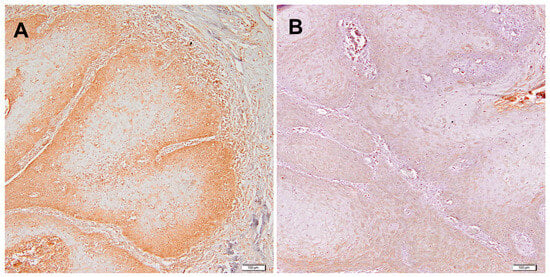
Figure 1
Open AccessArticle
Elucidating the Molecular Mechanisms of Pulsed Light-Induced Lycopene Accumulation in Tomatoes Through Integrated Multi-Omics Analysis
by
Guangning Na, Yeting Sun, Xueshan Wen, Chao Zhang and Xiaoyan Zhao
Int. J. Mol. Sci. 2025, 26(24), 11828; https://doi.org/10.3390/ijms262411828 (registering DOI) - 7 Dec 2025
Abstract
Tomato (Solanum lycopersicum L.) is rich in the antioxidant lycopene, which often degrades postharvest. Pulsed light shows promise in preserving lycopene, yet its molecular mechanisms remain unclear. This study integrates transcriptomics, proteomics, and metabolomics to elucidate how pulsed light affects lycopene synthesis
[...] Read more.
Tomato (Solanum lycopersicum L.) is rich in the antioxidant lycopene, which often degrades postharvest. Pulsed light shows promise in preserving lycopene, yet its molecular mechanisms remain unclear. This study integrates transcriptomics, proteomics, and metabolomics to elucidate how pulsed light affects lycopene synthesis in tomatoes. The results showed that lycopene content increased significantly in pulsed light-treated tomatoes. Transcriptomic analysis identified 1092 significantly differentially expressed genes (DEGs), proteomic analysis identified 1046 significantly differentially accumulated proteins (DAPs), and metabolomic analysis identified 272 significantly differentially accumulated metabolites (DEMs). These were significantly enriched in pathways such as terpenoid backbone biosynthesis, carotenoid biosynthesis, the tricarboxylic acid cycle (TCA), and photosynthesis. The upregulation of eight key genes central to lycopene biosynthesis was validated by qRT-PCR, confirming their involvement in the observed accumulation. Integrated multi-omics analysis revealed coordinated regulation of photosynthesis, carbohydrate metabolism, and terpenoid synthesis, highlighting the reprogramming of energy metabolism and secondary metabolite synthesis in lycopene accumulation. This study provides a comprehensive understanding of the molecular mechanisms by which pulsed light enhances lycopene content in tomatoes. The findings suggest that pulsed light treatment activates key metabolic pathways, leading to increased lycopene synthesis. This research offers a theoretical basis for optimizing pulsed light technology and developing new preservation strategies to maintain and enhance the nutritional quality of tomatoes during postharvest storage.
Full article
(This article belongs to the Section Molecular Plant Sciences)
Open AccessArticle
Diroximel Fumarate-Loaded Solid Lipid Nanoparticles (DRF-SLNs) as Potential Carriers for the Treatment of Multiple Sclerosis: Preformulation Study
by
Debora Santonocito, Giuliana Greco, Maria Grazia Sarpietro, Aurélie Schoubben, Claudia Sciacca, Giuseppe Romeo, Katia Mangano and Carmelo Puglia
Int. J. Mol. Sci. 2025, 26(24), 11827; https://doi.org/10.3390/ijms262411827 (registering DOI) - 7 Dec 2025
Abstract
Diroximel fumarate (DRF) is an orally administered prodrug used in multiple sclerosis (MS) treatment. Although it exhibits better gastrointestinal (GI) tolerability than its analogues, many patients still discontinue therapy due to frequent GI adverse events. To overcome these limitations, alternative drug delivery systems
[...] Read more.
Diroximel fumarate (DRF) is an orally administered prodrug used in multiple sclerosis (MS) treatment. Although it exhibits better gastrointestinal (GI) tolerability than its analogues, many patients still discontinue therapy due to frequent GI adverse events. To overcome these limitations, alternative drug delivery systems that bypass the GI tract are needed. Direct nose-to-brain delivery represents a promising approach to circumvent the blood–brain barrier and target the central nervous system; however, limited nasal mucosal absorption and the small volume of the nasal cavity pose significant challenges. Solid lipid nanoparticles (SLNs) can potentially overcome these obstacles by enhancing drug bioavailability and protecting against enzymatic degradation. This research aimed to develop an innovative intranasal nanoformulation of DRF to improve brain targeting and patient compliance. DRF-loaded SLNs were prepared using a solvent-diffusion technique with stearic acid as the lipid phase and Poloxamer 188 as the surfactant. The obtained nanoparticles displayed favorable technological characteristics, with a mean diameter of 210 nm, a polydispersity index of 0.17, and a zeta potential of −36 mV, suggesting good long-term stability. Interactions between SLNs and biomembrane models (MLV) were also studied to elucidate their cellular uptake mechanism. Future work will focus on evaluating the in vivo efficacy of this novel nanoformulation.
Full article
(This article belongs to the Special Issue Multiple Sclerosis: From Molecular Pathology to Novel Therapeutic Approaches)
Open AccessReview
Emerging Frontiers in Neuro-Oncology: Insights into Extracellular Vesicle-Driven Tumor Mechanisms and Nanotherapeutic Strategies
by
Tommaso Colangelo, Anna Alessia Saponaro, Gianluigi Mazzoccoli, Gaetano Serviddio and Rosanna Villani
Int. J. Mol. Sci. 2025, 26(24), 11826; https://doi.org/10.3390/ijms262411826 (registering DOI) - 7 Dec 2025
Abstract
Brain tumors encompass a heterogeneous group of neoplasms, including primary and secondary metastatic lesions, with glioblastoma multiforme (GBM) representing the most aggressive primary malignancy. Despite advancements in surgical resection, radiotherapy, and chemotherapy, the prognosis for GBM remains poor due to its infiltrative nature,
[...] Read more.
Brain tumors encompass a heterogeneous group of neoplasms, including primary and secondary metastatic lesions, with glioblastoma multiforme (GBM) representing the most aggressive primary malignancy. Despite advancements in surgical resection, radiotherapy, and chemotherapy, the prognosis for GBM remains poor due to its infiltrative nature, tumor heterogeneity and resistance mechanisms. Emerging diagnostic tools, such as liquid biopsies, and therapeutic strategies leveraging extracellular vesicles (EVs) are reshaping the field of neuro-oncology. EVs, lipid bilayer-enclosed particles secreted by cells, carry oncogenic cargo such as microRNAs and molecular chaperones, influencing tumor progression, immune evasion, and therapy resistance. Recent research highlights their potential as biomarkers for early diagnosis and vehicles for targeted drug delivery across the blood–brain barrier (BBB). EV-based nanotherapeutics show promise in improving treatment precision, reducing systemic toxicity, and advancing precision medicine in brain tumor management. However, challenges related to EV heterogeneity, cargo-loading efficiency, and large-scale production must be addressed to fully realize their therapeutic potential. This review explores the multifaceted roles of EVs in brain tumors, emphasizing their diagnostic, prognostic, and therapeutic applications.
Full article
(This article belongs to the Special Issue Novel Extracellular Vesicle-Based Therapy for Central Nervous System Diseases)
Open AccessArticle
Atelocollagen Increases Collagen Synthesis by Promoting Glycine Transporter 1 in Aged Mouse Skin
by
Kyung-A Byun, Seung Min Oh, Seyeon Oh, Hyoung Moon Kim, Myungjune Oh, Geebum Kim, Min Seung Kim, Kuk Hui Son and Kyunghee Byun
Int. J. Mol. Sci. 2025, 26(24), 11825; https://doi.org/10.3390/ijms262411825 (registering DOI) - 7 Dec 2025
Abstract
Aging results in decreased collagen synthesis and the disruption of extracellular matrix integrity, primarily due to increased oxidative stress. This study evaluated whether atelocollagen can restore collagen synthesis in aged skin by modulating glycine transporter 1 (GlyT1)-mediated glycine uptake, regulating oxidative stress, and
[...] Read more.
Aging results in decreased collagen synthesis and the disruption of extracellular matrix integrity, primarily due to increased oxidative stress. This study evaluated whether atelocollagen can restore collagen synthesis in aged skin by modulating glycine transporter 1 (GlyT1)-mediated glycine uptake, regulating oxidative stress, and influencing extracellular matrix remodeling factors in senescent human cells and the skin of older mice. Human dermal fibroblasts (HDFs) and aged mouse skin were treated with atelocollagen, with analyses of GlyT1 expression, glutathione and intracellular glycine concentrations, oxidative stress markers, nuclear factor-kappa-B (NF-κB) activity, matrix metalloproteinases (MMPs), SMAD proteins (SMADs) signaling, and collagen I/III. Treatment with GlyT1 inhibitors and glycine was tested. Atelocollagen significantly increased GlyT1 expression and intracellular glycine concentration, promoted glutathione synthesis, and reduced oxidative stress. These effects led to decreased NF-κB activity and MMP1/3/9 expression, increased SMAD2/3 phosphorylation, and upregulated type I/III collagen synthesis in senescent HDFs and aged mouse skin. All beneficial effects were blocked by GlyT1 inhibition and were generally superior to glycine alone. Histology showed increased collagen density and improved skin elasticity in atelocollagen-treated mice. In summary, atelocollagen enhances collagen synthesis and reduces oxidative stress in aged skin through GlyT1-dependent glycine transport, providing a potential strategy for skin rejuvenation.
Full article
(This article belongs to the Section Biochemistry)
Open AccessArticle
A Machine Learning Model Based on First-Trimester Lipidomic Signatures for Predicting Metabolic Pregnancy Complications
by
Alisa Tokareva, Natalia A. Frankevich, Vitaliy Chagovets, Anna Derenko, Vadim Lagutin, Vladimir Frankevich and Gennady Sukhikh
Int. J. Mol. Sci. 2025, 26(24), 11824; https://doi.org/10.3390/ijms262411824 (registering DOI) - 7 Dec 2025
Abstract
Gestational diabetes mellitus (GDM) and macrosomia are crucial for improving maternal and neonatal outcomes. Molecular dysregulations can manifest long before clinical symptoms appear. This study aimed to leverage first-trimester serum lipidomic signatures to build early predictive models for these complications. A case–control study
[...] Read more.
Gestational diabetes mellitus (GDM) and macrosomia are crucial for improving maternal and neonatal outcomes. Molecular dysregulations can manifest long before clinical symptoms appear. This study aimed to leverage first-trimester serum lipidomic signatures to build early predictive models for these complications. A case–control study was conducted using serum samples from 119 women during first-trimester screening: 40 cases and 79 controls for GDM prediction and 45 cases and 74 controls for macrosomia prediction (newborn weight more than 90 percentile). Lipidomic profiling was performed using shotgun mass spectrometry in both positive and negative electrospray ionization modes. After feature selection based on Shapley values, machine learning models—including Random Forest and XGBoost—were constructed and evaluated via 10-fold cross-validation. For GDM, potential early biomarkers included elevated levels of triacylglycerol (TG) 55:7 and decreased levels of 13-Docosenamide, plasmenyl-phosphatidylcholine (PC P)-36:2, and phosphatidylcholine (PC) 42:7. For macrosomia, phosphatidylglycerol (PG) (i-, a- 29:0), 4-Hydroxybutyric acid, and Pantothenol were significantly altered. The model for GDM prediction achieved a sensitivity of 87% and specificity of 89%. For macrosomia, the model demonstrated a sensitivity of 87% and specificity of 93%. The Random Forest and XGBoost models demonstrated comparable performance metrics on average. The risk ratio between the high- and low-risk groups defined by the models was 11.9 for GDM and 11.1 for macrosomia. Our findings demonstrate that first-trimester serum lipidomic profiles, combined with clinical data and interpreted by advanced machine learning, can accurately identify patients at high risk for GDM and macrosomia. This integrated approach holds significant promise for developing a clinical tool for timely intervention and personalized pregnancy management.
Full article
(This article belongs to the Section Molecular Endocrinology and Metabolism)
Open AccessReview
Epigenetic Mechanisms in Autoimmune Thyroid Diseases: Bridging Research and Clinical Applications
by
Shouxia Xiao, Yuelin Hu, Xin Wang and Hongsong Yu
Int. J. Mol. Sci. 2025, 26(24), 11823; https://doi.org/10.3390/ijms262411823 (registering DOI) - 7 Dec 2025
Abstract
Autoimmune thyroid disease (AITD) exemplifies an organ-specific autoimmune disorder, including Hashimoto’s thyroiditis (HT) and Graves’ disease (GD). HT is characterized by hypothyroidism, whereas GD primarily presents as hyperthyroidism. Immunological evidence indicates that AITD pathogenesis requires both a permissive genetic background and environmental triggers
[...] Read more.
Autoimmune thyroid disease (AITD) exemplifies an organ-specific autoimmune disorder, including Hashimoto’s thyroiditis (HT) and Graves’ disease (GD). HT is characterized by hypothyroidism, whereas GD primarily presents as hyperthyroidism. Immunological evidence indicates that AITD pathogenesis requires both a permissive genetic background and environmental triggers to initiate and sustain disease progression. However, the exact molecular and cellular pathways through which these elements synergize to trigger and sustain autoimmune responses remain unclear. Emerging evidence suggests that epigenetic regulation serves as the key interface decoding genetic predisposition through environmental stimuli in AITD etiology. Studies show that environmental epigenetic reprogramming initiates AITD development in genetically susceptible individuals. Epigenetic regulators, including DNA methylation, histone modifications, and non-coding RNA activity, finely tune transcriptional outputs to influence disease trajectories. Beyond elucidating AITD pathogenesis, these epigenetic alterations offer clinical value as diagnostic biomarkers and modifiable therapeutic targets, facilitating precision medicine approaches from early detection to customized interventions. These epigenetic modifications not only elucidate AITD pathophysiology but also provide measurable markers for early diagnosis and molecular targets for personalized treatment strategies.
Full article
(This article belongs to the Section Molecular Immunology)
Open AccessReview
Fibrin Monomer in Thrombosis and Haemostasis: A Clinical Biomarker and Beyond
by
Konstantin Guria, Ivan Melnikov, Valentina Shtelmakh, Yuliya Avtaeva, Sergey Okhota, Olga Saburova, Sergey Kozlov and Zufar Gabbasov
Int. J. Mol. Sci. 2025, 26(24), 11822; https://doi.org/10.3390/ijms262411822 (registering DOI) - 7 Dec 2025
Abstract
Fibrin monomer (FM) is a transient intermediate of blood coagulation that functions as both an active regulator of haemostasis and a sensitive biomarker for prothrombotic states. Clinically, FM is measured indirectly as its derivative, soluble fibrin monomer complexes (SFMC), which is also often
[...] Read more.
Fibrin monomer (FM) is a transient intermediate of blood coagulation that functions as both an active regulator of haemostasis and a sensitive biomarker for prothrombotic states. Clinically, FM is measured indirectly as its derivative, soluble fibrin monomer complexes (SFMC), which is also often referred to as FM throughout the clinical literature. FM participates in a complex regulatory network modulating thrombin generation and fibrinolysis, interacting with platelet receptors, including integrin αIIbβ3 and GPVI, and engaging GPIb-vWF interactions. This comprehensive review examines FM’s molecular mechanisms in haemostatic regulation and evaluates clinical evidence for FM as a biomarker. Particular focus is placed on FM’s utility for risk stratification across thrombotic conditions, including disseminated intravascular coagulation, venous thromboembolism, ischemic stroke, myocardial infarction, and COVID-19-associated coagulopathy. Current challenges, including assay standardization and universal cut-off values, are discussed. By synthesizing mechanistic insights with clinical data, this integrated perspective may accelerate the translation of FM biology into improved risk assessment tools and novel therapeutic strategies.
Full article
(This article belongs to the Special Issue New Advances in Thrombosis: 3rd Edition)
Open AccessArticle
From Autoimmune Sialadenitis to Central Pain: Hypothesizing Shared Pathogenesis for Fibromyalgia and Primary Sjogren’s Disease and Identifying Essential Screening Strategies
by
Marta Magdalena Jaskólska, Iga Kościńska-Shukla, Kinga Grochowalska, Michał Olech, Zofia Mikołajczak, Magdalena Chylińska, Natalia Aleksandra Dułak, Magdalena Rytlewska, Paulina Pikus and Michał Chmielewski
Int. J. Mol. Sci. 2025, 26(24), 11821; https://doi.org/10.3390/ijms262411821 (registering DOI) - 7 Dec 2025
Abstract
Even though primary Sjögren disease (pSjD) is mainly associated with sicca symptoms, there are extraglandular manifestations of the disease which affect the quality of life of patients the most and may even be life-threatening. Among the most severe, polyneuropathy and myopathy are worth
[...] Read more.
Even though primary Sjögren disease (pSjD) is mainly associated with sicca symptoms, there are extraglandular manifestations of the disease which affect the quality of life of patients the most and may even be life-threatening. Among the most severe, polyneuropathy and myopathy are worth mentioning. Additionally, clinical observations suggest a higher prevalence of fibromyalgia (FM) in this group of patients, clouding physicians’ assessment and potentially leading to unsuccessful therapeutic decisions. The aim of our study was to evaluate the frequency of pSjD and FM co-occurrence as well as to find the most effective screening tools and markers of such overlap. A total of 97 consecutive patients with diagnosed pSjD were incorporated in the study after obtaining their informed consent. Participants completed a set of broadly available questionnaires, including Fibromyalgia Survey Questionnaire, SF-36 and EULAR Sjögren’s Syndrome Patient-Reported Index (ESSPRI). Data on their laboratory results was collected in the dedicated database. Moreover, patients underwent electroneurographic (ENG) and electromyographic (EMG) testing. Central nervous system (CNS) abnormalities were detected using MRI. Objective disease activity was evaluated based on EULAR Sjögren’s Syndrome Disease Activity Index (ESSDAI). The mean age was 55.3 (range 19.0–78.0 years, SD = 13.9). The disease duration ranged from 2 to 42 years (M = 9.03 years, SD = 7.1 years). Nearly half of the participants (n = 44, 45%) met diagnostic criteria of FM. Interestingly, the diagnosis of FM correlated with CNS involvement. There was no significant correlation between FM and either polyneuropathy/myopathy nor laboratory findings (however, C3c and folic acid concentrations were near the level of significance—mean 1.2 vs. 1.29; p = 0.075 and mean 11.35 vs. 9.21; p = 0.071, respectively). Within the subcategories of SF-36 and ESSPRI scales, significant positive correlation was noted with ESSPRI total score and ESSPRI pain score (neuropathic subcategory), while a negative correlation was found with SF-36 vitality score, physical functioning score, and the SF-36 total score. FM is common among pSjD patients and should be considered rather a comorbidity requiring different therapeutic approaches. At the fast-paced clinical environment, a concise ESSPRI assessment may be helpful in the initial screening of patients at risk of FM. Even though the origin of this phenomenon is unknown, the concepts of central sensitization and microglia polarization may be potential explanations and more molecular research in this direction could benefit the pSjD patients.
Full article
(This article belongs to the Special Issue Sjogren's Disease: Multidimensional Perspectives on Pathogenesis, Clinical Manifestations, and Therapeutic Advancements)
Open AccessArticle
Global Proteomic Determination of the Poly-Pharmacological Effects of PARP Inhibitors Following Treatment of High-Grade Serous Ovarian Cancer Cells
by
Jesenia M. Perez, Valerie Barrera-Estrada, Carly A. I. Twigg and Stefani N. Thomas
Int. J. Mol. Sci. 2025, 26(24), 11820; https://doi.org/10.3390/ijms262411820 (registering DOI) - 7 Dec 2025
Abstract
High-grade serous ovarian cancer (HGSOC) is the most commonly diagnosed ovarian cancer subtype. Approximately half of all patients diagnosed with HGSOC are deficient in homologous recombination (HR), harbor BRCA1/2 mutations, and are treated with poly (ADP-ribose) polymerase (PARP) inhibitors (PARPis). FDA-approved PARPis Olaparib,
[...] Read more.
High-grade serous ovarian cancer (HGSOC) is the most commonly diagnosed ovarian cancer subtype. Approximately half of all patients diagnosed with HGSOC are deficient in homologous recombination (HR), harbor BRCA1/2 mutations, and are treated with poly (ADP-ribose) polymerase (PARP) inhibitors (PARPis). FDA-approved PARPis Olaparib, Niraparib, and Rucaparib all contribute to adverse effects in patients due to their poly-pharmacological properties. This feature necessitates investigation of global protein responses to PARPi treatment beyond DNA repair in the context of BRCA mutational status and HR deficiency. We sought to determine the landscape of differential PARPi-induced proteomes in HGSOC cells exhibiting different BRCA1/2 mutational statuses. Here, we applied immunofluorescence microscopy to detect γH2AX, Rad51, and geminin foci as markers of DNA damage and repair upon treatment of HGSOC cells with IC50 doses of PARPis. Global proteome perturbations upon PARPi treatment were measured using quantitative mass spectrometry-based proteomics. The proteomic data highlighted cell line effects, masking high-dose PARPi treatment response. Interrogation of PARPi response within biological pathways identified through gene set enrichment analysis (GSEA) revealed significant changes to proteins involved in Epithelial–Mesenchymal Transition (EMT), E2F targets, and cholesterol homeostasis. Our study establishes proteomic evidence supporting the poly-pharmacological characteristics of Niraparib, Olaparib, and Rucaparib in HGSOC cells.
Full article
(This article belongs to the Special Issue Molecular Genetics in Ovarian Cancer)
Open AccessReview
Why “Where” Matters as Much as “How Much”: Single-Cell and Spatial Transcriptomics in Plants
by
Kinga Moskal, Marta Puchta-Jasińska, Paulina Bolc, Adrian Motor, Rafał Frankowski, Aleksandra Pietrusińska-Radzio, Anna Rucińska, Karolina Tomiczak and Maja Boczkowska
Int. J. Mol. Sci. 2025, 26(24), 11819; https://doi.org/10.3390/ijms262411819 (registering DOI) - 7 Dec 2025
Abstract
Plant tissues exhibit a layered architecture that makes spatial context decisive for interpreting transcriptional changes. This review explains why the location of gene expression is as important as its magnitude and synthesizes advances uniting single-cell/nucleus RNA-seq with spatial transcriptomics in plants. Surveyed topics
[...] Read more.
Plant tissues exhibit a layered architecture that makes spatial context decisive for interpreting transcriptional changes. This review explains why the location of gene expression is as important as its magnitude and synthesizes advances uniting single-cell/nucleus RNA-seq with spatial transcriptomics in plants. Surveyed topics include platform selection and material preparation; plant-specific sample processing and quality control; integration with epigenomic assays such as single-nucleus Assay for Transposase-Accessible Chromatin using sequencing (ATAC) and Multiome; and computational workflows for label transfer, deconvolution, spatial embedding, and neighborhood-aware cell–cell communication. Protoplast-based single-cell RNA sequencing (scRNA-seq) enables high-resolution profiling but introduces dissociation artifacts and cell-type biases, whereas ingle-nucleus RNA sequencing (snRNA-seq) improves the representation of recalcitrant lineages and reduces stress signatures while remaining compatible with multiomics profiling. Practical guidance is provided for mitigating ambient RNA, interpreting organellar and intronic metrics, identifying doublets, and harmonizing batches across chemistries and studies. Spatial platforms (Visium HD, Stereo-seq, bead arrays) and targeted imaging (Single-molecule fluorescence in situ hybridization (smFISH), Hairpin-chain-reaction FISH (HCR-FISH), Multiplexed Error-Robust Fluorescence In Situ Hybridization (MERFISH) ) are contrasted with plant-specific adaptations and integration pipelines that anchor dissociated profiles in anatomical coordinates. Recent atlases in Arabidopsis, soybean, and maize illustrate how cell identities, chromatin accessibility, and spatial niches reveal developmental trajectories and stress responses jointly. A roadmap is outlined for moving from atlases to interventions by deriving gene regulatory networks, prioritizing cis-regulatory targets, and validating perturbations with spatial readouts in crops. Together, these principles support a transition from descriptive maps to mechanism-informed, low-pleiotropy engineering of agronomic traits.
Full article
(This article belongs to the Special Issue Plant Physiology and Molecular Nutrition: 2nd Edition)
Open AccessArticle
Study of Vibronic and Cationic Features of m-Diethoxybenzene via REMPI, Hole-Burning, and MATI Spectroscopy
by
Xiateng Qin, Chunyang Duan, Yan Zhao, Changyong Li and Suotang Jia
Int. J. Mol. Sci. 2025, 26(24), 11818; https://doi.org/10.3390/ijms262411818 (registering DOI) - 7 Dec 2025
Abstract
Phenetole derivatives are widely used in various fields, and the presence of the ethoxy group, with its longer alkyl chain, suggests the possibility of multiple rotamers. In particular, diethoxybenzene derivatives, containing two ethoxy groups, exhibit an even greater number of rotameric forms. In
[...] Read more.
Phenetole derivatives are widely used in various fields, and the presence of the ethoxy group, with its longer alkyl chain, suggests the possibility of multiple rotamers. In particular, diethoxybenzene derivatives, containing two ethoxy groups, exhibit an even greater number of rotameric forms. In this study, we report the first investigation of the stable structures, vibronic spectra, and cationic spectra of different rotamers of m-diethoxybenzene (MDEB). Resonance-enhanced multiphoton ionization (REMPI) spectra of the rotamers were identified via hole-burning (HB) experiments, while mass-analyzed threshold ionization (MATI) spectra provided precise adiabatic ionization energies (IEs) of the observed rotamers, as well as the active vibrations of their corresponding cations. Density functional theory (DFT) calculations predicted thirteen rotamers of MDEB, but only two rotamers were observed in the supersonic molecular beam. The band origins of the S1 ← S0 transition and the adiabatic IEs of the down–up and down–down rotamers of MDEB were determined to be 36,091 ± 2 cm−1 and 36,165 ± 2 cm−1 and 62,419 ± 5 cm−1 and 63,378 ± 5 cm−1, respectively. Franck–Condon spectral simulations for the S1 ← S0 and D0 ← S1 transitions were performed based on DFT calculations, and the theoretical results showed good agreement with the experimental data. Vibrational features observed in the S1 and D0 states were assigned by comparing the experimentally measured spectra with the simulated spectra as well as the previously reported vibrational spectra of structurally similar molecules. Finally, several key findings and molecular characteristics are discussed in detail.
Full article
(This article belongs to the Special Issue Advanced Spectroscopy Research: New Findings and Perspectives)
►▼
Show Figures
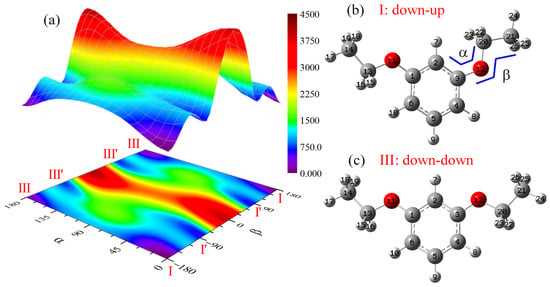
Figure 1
Open AccessArticle
Novel Mono-Substituted 4H-1,2,6-Thiadiazines with Antioxidant and Anti-Lipoxygenase Activities
by
Eleftherios Charissopoulos, Panayiotis A. Koutentis, Andreas S. Kalogirou and Eleni Pontiki
Int. J. Mol. Sci. 2025, 26(24), 11817; https://doi.org/10.3390/ijms262411817 (registering DOI) - 7 Dec 2025
Abstract
Τhe synthesis of a novel series of mono-substituted 4H-1,2,6-thiadiazine derivatives was reported, aiming at enhancing antioxidant and lipoxygenase inhibitory activities via pharmacophore combination. The compounds were prepared from 3,5-dichloro-4H-1,2,6-thiadiazin-4-one and 2-(3,5-dichloro-4H-1,2,6-thiadiazin-4-ylidene)malononitrile. All the derivatives were evaluated for
[...] Read more.
Τhe synthesis of a novel series of mono-substituted 4H-1,2,6-thiadiazine derivatives was reported, aiming at enhancing antioxidant and lipoxygenase inhibitory activities via pharmacophore combination. The compounds were prepared from 3,5-dichloro-4H-1,2,6-thiadiazin-4-one and 2-(3,5-dichloro-4H-1,2,6-thiadiazin-4-ylidene)malononitrile. All the derivatives were evaluated for radical scavenging activity towards 2,2-diphenyl-1-picrylhydrazyl (DPPH), 2,2′-azobis(2-methylpropionamidine) dihydrochloride (AAPH)-induced lipid peroxidation inhibition, and soybean lipoxygenase (sLOX) inhibition. The compounds exhibited moderate to good antioxidant activity and variable sLOX inhibition. Notably, 2-[3-(benzo[d]oxazol-2-ylthio)-5-chloro-4H-1,2,6-thiadiazin-4-ylidene]malononitrile showed the strongest antioxidant effect (92% DPPH scavenging at 60 min and 70% inhibition of AAPH-induced lipid peroxidation) but low sLOX inhibition, whereas 3-chloro-5-(4-phenylpiperazin-1-yl)-4H-1,2,6-thiadiazin-4-one displayed the most potent sLOX inhibition (IC50: 7.5 μM), with a docking score of −8.3 kcal/mol developing hydrophobic interactions with Phe134 and Val520.
Full article
(This article belongs to the Section Biochemistry)
►▼
Show Figures
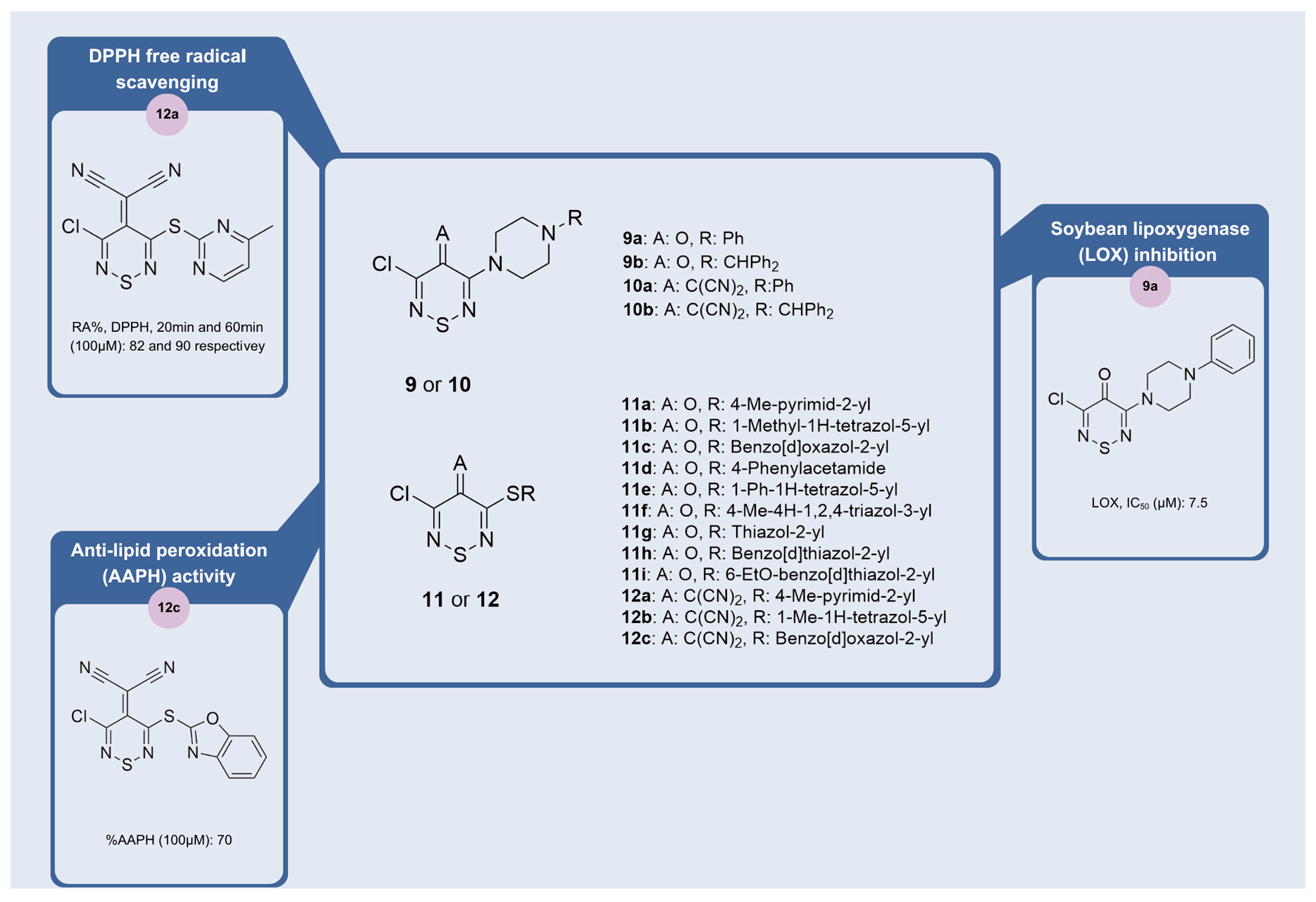
Graphical abstract
Open AccessReview
From Inflammation to Malignancy: The Link Between Endometriosis and Gynecological Cancers
by
Karolina Kłodnicka, Aleksandra Michalska, Jacek Januszewski, Alicja Forma, Grzegorz Teresiński, Jolanta Flieger, Jacek Bogucki, Marcin Maciejewski, Kinga Syty and Jacek Baj
Int. J. Mol. Sci. 2025, 26(24), 11816; https://doi.org/10.3390/ijms262411816 (registering DOI) - 7 Dec 2025
Abstract
Endometriosis, a chronic estrogen-dependent disease, is associated with a risk of developing gynecological cancers. The mechanisms of this association remain unclear, but emerging evidence implicates key signaling pathways, including PI3K/AKT/mTOR and ARID1A alterations, in malignant transformation. This article examines current reports on the
[...] Read more.
Endometriosis, a chronic estrogen-dependent disease, is associated with a risk of developing gynecological cancers. The mechanisms of this association remain unclear, but emerging evidence implicates key signaling pathways, including PI3K/AKT/mTOR and ARID1A alterations, in malignant transformation. This article examines current reports on the association between endometriosis and cervical, ovarian, and endometrial cancers, with particular emphasis on diagnostic challenges and molecular mechanisms. Imaging methods such as ultrasound, magnetic resonance imaging, and computed tomography (CT) are used for diagnosis, as well as biomarkers such as Cancer Antigen-125 (CA-125) and Human Epididymal protein 4 (HE4), but their specificity is limited, motivating research into novel molecular and non-invasive diagnostics. Laparoscopy is an invasive diagnostic method, serving as the gold standard for confirming the diagnosis. We discuss personalized clinical strategies, including risk-based surveillance for patients with atypical lesions or ARID1A alterations, and implications for ovarian cancer management in endometriosis. Prospective cohort studies will be necessary to further understand the complex mechanisms of endometriosis’s malignant transformation. Optimizing therapy and improving quality of life require a holistic, individualized approach to patient care. This review provides an integrated synthesis of epidemiological and molecular evidence, highlighting both established and emerging targets for diagnosis and treatment in endometriosis-associated malignancies.
Full article
(This article belongs to the Special Issue Molecular Advances in Gynecologic Cancer, 2nd Edition)
►▼
Show Figures
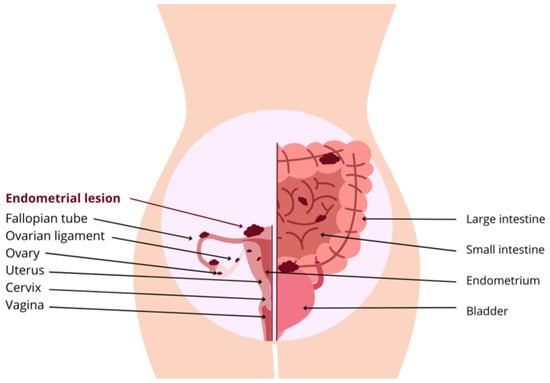
Figure 1
Open AccessArticle
Spatial Multi-Omics Analysis of the Qianqiu Goat Gut Microbiome and Metabolome
by
Panpan Guo, Wenjuan Qin, Wencheng Song and Hongquan Chen
Int. J. Mol. Sci. 2025, 26(24), 11815; https://doi.org/10.3390/ijms262411815 (registering DOI) - 7 Dec 2025
Abstract
This study profiled the rumen (RM), small intestine (SI), and large intestine (LI) of 24 samples collected from eight 6-month-old Qianqiu goats (body weight 28.40 ± 1.80 kg), with the samples equally divided into three groups. A combination of methods was used, including
[...] Read more.
This study profiled the rumen (RM), small intestine (SI), and large intestine (LI) of 24 samples collected from eight 6-month-old Qianqiu goats (body weight 28.40 ± 1.80 kg), with the samples equally divided into three groups. A combination of methods was used, including 16S rRNA sequencing, untargeted liquid chromatography–mass spectrometry (LC-MS) metabolomics, Orthogonal Partial Least Squares Discriminant Analysis (OPLS-DA), Kyoto Encyclopedia of Genes and Genomes (KEGG) enrichment, and weighted gene co-expression network analysis-based module detection (WGCNA) with network integration. An uncommon composition of organisms dominated the SI: the hydrogenotrophic methanogens Methanobrevibacter (SI 24.51%; RM 1.92%; LI 2.19%) and Methanosphaera (SI 0.43%; RM 0.02%; LI 0.02%), together with the acetogen Acetitomaculum (SI 1.58%; RM 0.34%; LI 0.11%), were markedly more abundant compared to the RM or LI. Correlation and pathway analyses indicated that Methanobrevibacter was positively correlated with a steroid-type lipid metabolite (r = 0.52, p < 0.05) and with bile-acid-related metabolites. Acetitomaculum was positively correlated with several metabolites: 4-Hydroxyphenyl 4-hydroxybenzoate (r = 0.79, p < 0.05), 2-Aminoethyl dihydrogen phosphate (r = 0.76, p < 0.05), 1-Myristoyl-2-stearoyl-sn-glycero-3-phosphocholine (r = 0.76, p < 0.05), and 1,2-Dioleoyl-sn-Glycero-3-Phosphocholine (r = 0.74, p < 0.05). Together, these data define a small-intestinal microbial–metabolite module in Qianqiu goats characterized by elevated abundances of specific methanogens and acetogens in the SI. Specific positive correlations were identified between these taxa and metabolites associated with lipids and bile acids.
Full article
(This article belongs to the Topic Advances in Molecular Genetics and Breeding of Cattle, Sheep, and Goats)
►▼
Show Figures
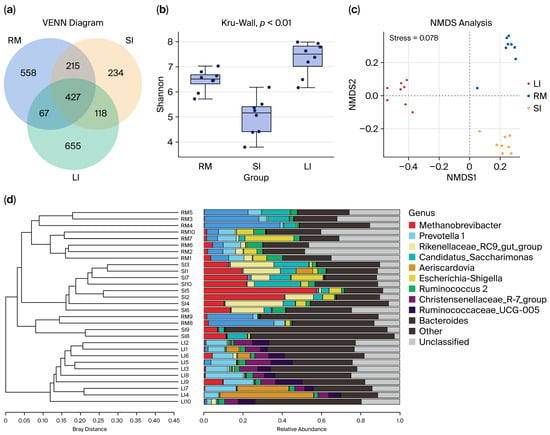
Figure 1
Open AccessArticle
Microbial Consortium Application Under Temperature Stress: Effects on the Rhizosphere Microbiome and Plant Growth
by
Ekaterina Alexeevna Sokolova, Natalya Valentinovna Smirnova, Valeria Aleksandrovna Fedorets, Inna Viktorovna Khlistun, Olga Viktorovna Mishukova, Irina Nikolaevna Tromenschleger, Oleg Aleksandrovich Savenkov, Oleg Igorevich Saprikin, Evgeny Ivanovich Rogaev, Maria Dmitrievna Buyanova, Irina Mikhailovna Filippova, Taisiya Maksimovna Mayorova, Marina Andreevna Glukhova, Mitina Maria Ivanovna, Andrey Dmitrievich Manakhov and Elena Nikolaevna Voronina
Int. J. Mol. Sci. 2025, 26(24), 11814; https://doi.org/10.3390/ijms262411814 (registering DOI) - 7 Dec 2025
Abstract
The aim of the present study was to investigate the effect of a synthetic microbial consortium (SMC) containing five functionally different bacterial strains (Rahnella aquatilis, Rothia endophytica, Stenotrophomonas indicatrix, Burkholderia contaminans, Lelliotia amnigena) on the growth and
[...] Read more.
The aim of the present study was to investigate the effect of a synthetic microbial consortium (SMC) containing five functionally different bacterial strains (Rahnella aquatilis, Rothia endophytica, Stenotrophomonas indicatrix, Burkholderia contaminans, Lelliotia amnigena) on the growth and development of three agricultural crops (wheat, buckwheat, and rapeseed) on two soil types (chernozem and gray forest soil) under field conditions. The experiment was conducted from June to September 2024 under extreme field conditions, with temperatures reaching 43.8 °C. This study evaluates SMC efficacy under severe abiotic stress, reflecting increasingly common climate extremes. Metagenomic data analysis showed that the introduced strains did not establish stable populations in the soil, possibly due to heat-induced bacterial mortality, though other factors including competition with indigenous microflora and lack of protective formulations may have also contributed. No statistically significant effects on plant morphometric parameters were observed. The extreme temperature and water stress conditions appear to have been the dominant limiting factors, overriding any potential benefits from microbial inoculation, as evidenced by the lack of response to mineral fertilizer application as well. Crop-specific effects were revealed: when cultivating rapeseed on chernozem, a significant increase in available phosphorus content was noted (from 278 ± 45 to 638 ± 92 mg/kg with SMC application, p < 0.001).
Full article
Open AccessArticle
Association Study of Hyaluronan-Binding Protein 2 (HABP2) Gene Polymorphisms in Idiopathic Recurrent Pregnancy Loss (RPL) in Korean Women
by
Jeong Yong Lee, Young Ran Kim, Eun Ju Ko, Hyeon Woo Park, Jae Hyun Lee, Seung Ho Hong, Ji Eun Shin, Eun Hee Ahn, Ji Hyang Kim and Nam Keun Kim
Int. J. Mol. Sci. 2025, 26(24), 11813; https://doi.org/10.3390/ijms262411813 (registering DOI) - 7 Dec 2025
Abstract
Recurrent pregnancy loss (RPL), also termed recurrent spontaneous abortion, is defined as the failure of ≥2 consecutive pregnancies before 20 weeks of gestation. Approximately 5% of pregnant couples experience RPL. The hyaluronan-binding protein 2 (HABP2) gene is involved in coagulation and
[...] Read more.
Recurrent pregnancy loss (RPL), also termed recurrent spontaneous abortion, is defined as the failure of ≥2 consecutive pregnancies before 20 weeks of gestation. Approximately 5% of pregnant couples experience RPL. The hyaluronan-binding protein 2 (HABP2) gene is involved in coagulation and plays an important role during pregnancy. In >50% of RPLs, the etiology remains unexplained. We collected 765 blood samples from 388 female RPL patients and 377 healthy female controls. To investigate the relationships between HABP2 polymorphisms and RPL, we examined six HABP2 variants (rs3832698 A>del, rs10885478 G>A, rs932650 T>C, rs7923349 G>T, rs1157916 G>A, and rs2240879 T>C) to clarify their association with RPL risk. The rs2240879 CC genotype was significantly associated with an increased RPL risk (p = 0.028). In haplotype analysis, the combination of rs3832698 del and rs2240879 T (del-T) was associated with elevated risk (p = 0.043); this risk persisted in combinations with additional polymorphisms (rs3832698 A>del, rs10885478 G>A, rs932650 T>C, rs7923349 G>T; del-A-T-T, p < 0.001; rs3832698 A>del, rs10885478 G>A, rs932650 T>C, rs7923349 G>T, rs1157916 G>A, rs2240879 T>C; del-A-C-T-G-T, p = 0.024). The rs3832698 and rs1157916 genotypes were significantly associated with prothrombin time (p = 0.020 and p = 0.012, respectively). We identified associations between HABP2 polymorphisms and RPL; rs2240879 was linked to an increased RPL risk. Additionally, rs3832698 was associated with an altered prothrombin time. These findings suggest that HABP2 represents a biomarker for RPL susceptibility.
Full article
(This article belongs to the Section Molecular Genetics and Genomics)
►▼
Show Figures
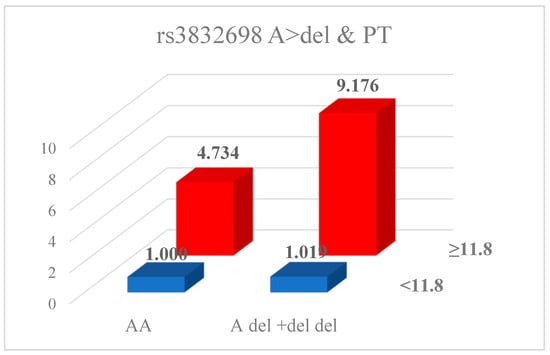
Figure 1
Open AccessReview
Genetic and Epigenetic Risks of Male Infertility in ART
by
Athanasios Zikopoulos, Periklis Katopodis, Maria Filiponi, Athanasios Zachariou, Athanasia Sesse, Ioanna Bouba, Charilaos Kostoulas, Sofia Markoula and Ioannis Georgiou
Int. J. Mol. Sci. 2025, 26(24), 11812; https://doi.org/10.3390/ijms262411812 (registering DOI) - 7 Dec 2025
Abstract
Assisted reproductive technologies (ART) and, in particular, intracytoplasmic sperm injection (ICSI) transformed the management of male infertility by making fertility possible in previously untreatable cases. However, the bypassing of natural selection mechanisms at fertilization is fraught with the danger of transmission of genetic
[...] Read more.
Assisted reproductive technologies (ART) and, in particular, intracytoplasmic sperm injection (ICSI) transformed the management of male infertility by making fertility possible in previously untreatable cases. However, the bypassing of natural selection mechanisms at fertilization is fraught with the danger of transmission of genetic and epigenetic abnormalities. Male infertility is now a multifactorial disorder with notable contributions from single-gene defects, chromosomal abnormalities, and Y-chromosome microdeletions. The recent advances in next-generation sequencing and sperm omics have identified mutations and copy-number variations in genes critical for spermatogenesis, flagellar structure, and endocrine regulation. Along with these findings, an increasing body of evidence suggests that ART procedures can lead to a disruption of epigenetic reprogramming during gametogenesis and early embryogenesis, resulting in imprinting disorders and altered patterns of gene expression in the offspring. This review synthesizes recent progress in the molecular underpinnings of genetic and epigenetic hazards of ART, with an emphasis on clinical significance for reproductive counselling and ethical considerations for future generations.
Full article
(This article belongs to the Special Issue Molecular Pathways to Infertility)
►▼
Show Figures
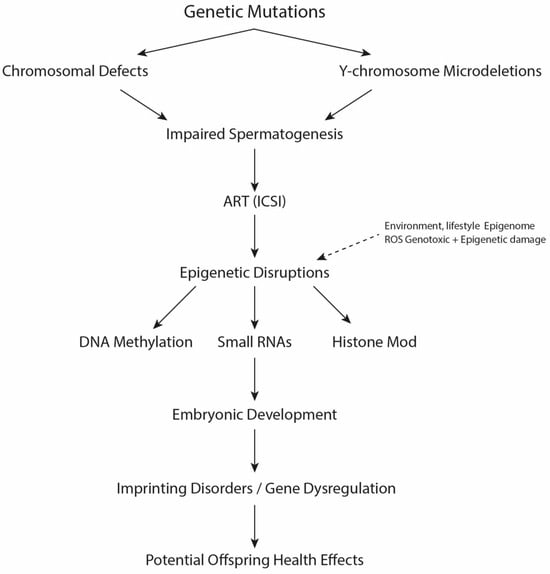
Figure 1

Journal Menu
► ▼ Journal Menu-
- IJMS Home
- Aims & Scope
- Editorial Board
- Reviewer Board
- Topical Advisory Panel
- Instructions for Authors
- Special Issues
- Topics
- Sections & Collections
- Article Processing Charge
- Indexing & Archiving
- Most Cited & Viewed
- Journal Statistics
- Journal History
- Journal Awards
- Society Collaborations
- Conferences
- Editorial Office
Journal Browser
► ▼ Journal Browser-
arrow_forward_ios
Forthcoming issue
arrow_forward_ios Current issue - Vol. 26 (2025)
- Vol. 25 (2024)
- Vol. 24 (2023)
- Vol. 23 (2022)
- Vol. 22 (2021)
- Vol. 21 (2020)
- Vol. 20 (2019)
- Vol. 19 (2018)
- Vol. 18 (2017)
- Vol. 17 (2016)
- Vol. 16 (2015)
- Vol. 15 (2014)
- Vol. 14 (2013)
- Vol. 13 (2012)
- Vol. 12 (2011)
- Vol. 11 (2010)
- Vol. 10 (2009)
- Vol. 9 (2008)
- Vol. 8 (2007)
- Vol. 7 (2006)
- Vol. 6 (2005)
- Vol. 5 (2004)
- Vol. 4 (2003)
- Vol. 3 (2002)
- Vol. 2 (2001)
- Vol. 1 (2000)
Highly Accessed Articles
Latest Books
E-Mail Alert
News
3 December 2025
Meet Us at the 5th Molecules Medicinal Chemistry Symposium, 14–17 May 2026, Beijing, China
Meet Us at the 5th Molecules Medicinal Chemistry Symposium, 14–17 May 2026, Beijing, China

2 December 2025
Meet Us at the 2nd International Conference on Bioengineering (BIOENG 2026)—Bioengineering in an Era of AI, 11–13 November 2026, Barcelona, Spain
Meet Us at the 2nd International Conference on Bioengineering (BIOENG 2026)—Bioengineering in an Era of AI, 11–13 November 2026, Barcelona, Spain

Topics
Topic in
Biophysica, CIMB, Diagnostics, IJMS, IJTM
Molecular Radiobiology of Protons Compared to Other Low Linear Energy Transfer (LET) Radiation
Topic Editors: Francis Cucinotta, Jacob RaberDeadline: 20 December 2025
Topic in
Antioxidants, Chemistry, IJMS, Molecules, Pharmaceutics
Natural Bioactive Compounds as a Promising Approach to Mitigating Oxidative Stress
Topic Editors: Andrea Ragusa, Filomena CorboDeadline: 31 December 2025
Topic in
Agriculture, Agronomy, Crops, Plants, IJMS, IJPB
Plant Responses and Tolerance to Salinity Stress, 2nd Edition
Topic Editors: Ricardo Aroca, Pablo CornejoDeadline: 15 January 2026
Topic in
Chemistry, Inorganics, IJMS, Pharmaceuticals
Natural Coumarin and Metal Complexes: Pharmacological Properties and Potential ApplicationsTopic Editors: Dušan Dimić, Edina Avdović, Dejan MilenkovićDeadline: 31 January 2026

Conferences
Special Issues
Special Issue in
IJMS
Biophysical Characterization and Molecular Engineering of Multidomain Proteins (4th Edition)
Guest Editors: Koichi Kato, Takayuki UchihashiDeadline: 10 December 2025
Special Issue in
IJMS
Molecular Mechanisms of Obesity and Metabolic Diseases
Guest Editor: Liliya MihaylovaDeadline: 15 December 2025
Special Issue in
IJMS
Pathogenesis and Molecular Therapy of Brain Tumor
Guest Editor: Theo KrausDeadline: 15 December 2025
Topical Collections
Topical Collection in
IJMS
Genetics and Molecular Breeding in Plants
Collection Editor: Pedro Martínez-Gómez
Topical Collection in
IJMS
Pharmaceutical Nanoimaging and Nanoengineering
Collection Editor: Yuri Lyubchenko
Topical Collection in
IJMS
Latest Review Papers in Molecular Genetics and Genomics
Collection Editor: Salvatore Saccone
Topical Collection in
IJMS
State-of-the-Art Macromolecules in Japan
Collection Editors: Ryoichi Arai, Shunsuke Tomita, Tamotsu Zako, Masafumi Odaka



